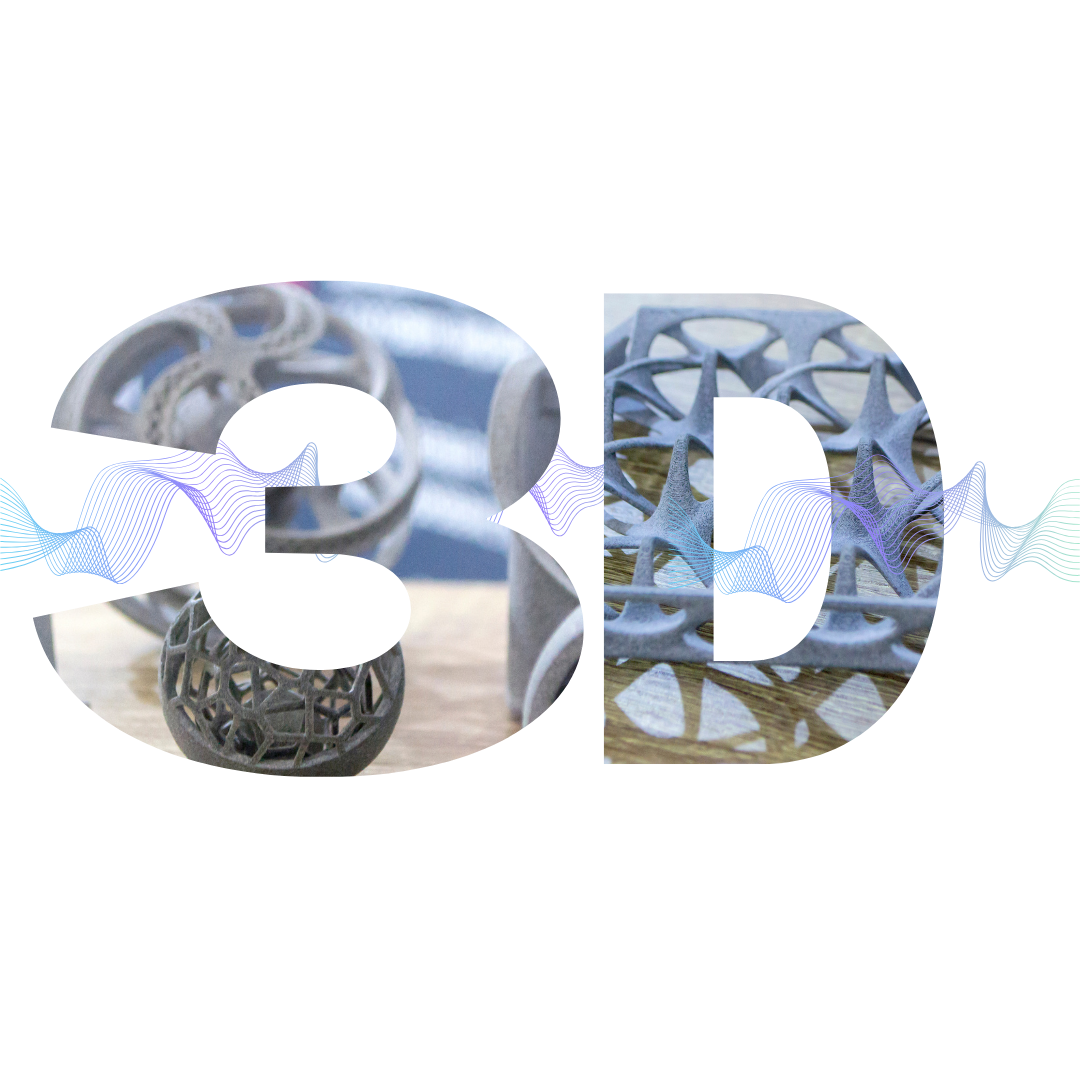The Future of Additive Manufacturing in Consumer Goods, Energy, and New Materials
In the ever-evolving world of technology, 3D printing is emerging as a game-changer across multiple sectors. From consumer packaged goods (CPG) and life sciences to oil/gas/energy, defense/aerospace, and chemical/materials, the ability to produce complex, customized products quickly and efficiently is transforming industries. As businesses increasingly adopt 3D printing technologies, they are realizing major improvements in sustainability, cost-effectiveness, and accelerated innovation cycles.
In the next five years – whether in personalized nutrition in the food and beverage industry, on-demand production in non-food CPG, or efficient energy solutions in oil and gas – the potential applications for 3D printing technologies are nearly limitless. Additionally, the life sciences and defense sectors continue to benefit from rapid prototyping, custom parts production, and advanced medical solutions. This blog will explore how 3D printing is driving innovation and reshaping the future of these industries.
Innovations Shaping the Future of the CPG Food & Beverage Industry
Key Impact Areas: Personalized Nutrition, Sustainable Packaging, and Novel Food Production
The CPG (Food & Beverage) industry is increasingly focused on delivering convenient, high-quality products that meet consumer demand for taste, nutrition, and affordability. This industry is constantly evolving to adapt to consumer trends such as health-conscious consumption, sustainability, and innovative packaging solutions, while also facing complex challenges related to supply chain efficiency and regulatory compliance.
Impact Areas: Personalized Nutrition, Sustainable Packaging, and Novel Food Production
- Personalized Nutrition and Customization: 3D printing technology is making waves in the food industry, enabling the creation of customized meals based on individual dietary needs and preferences. Over the next five years, 3D printing has the potential to expand further into personalized nutrition for health-conscious consumers, providing on-demand meals with precise caloric content, vitamins, and nutritional profiles tailored to specific health conditions or lifestyles.
- Sustainable Food Production: 3D printing can also help reduce food waste by using alternative ingredients like algae, insect proteins, or cell-based meats to create nutritious meals with unique textures and designs, while generating a much smaller environmental footprint.
- Innovative Packaging: 3D printing offers the potential for novel biodegradable or custom-designed packaging solutions that reduce material waste while maintaining or improving performance. In the next five years, expect an increased focus on packaging solutions that are tailored to custom product specifications, more sustainable, and easier to recycle.
Innovations for the Consumer Packaged Goods Industry
Major Impact Areas: Product Customization, Sustainable Manufacturing, and Supply Chain Optimization
The CPG (Non-Food) industry (encompassing the production, packaging, and distribution of consumer packaged goods that are not intended for consumption, including personal care products, household items, cleaning supplies, cosmetics, and over-the-counter healthcare products) focuses on delivering essential everyday products that provide convenience, hygiene, and functionality to consumers. This industry is heavily influenced by trends such as sustainability, product personalization, and innovative packaging, while also addressing challenges like supply chain management, cost efficiency, and regulatory standards.
Impact Areas: Product Customization, Sustainable Manufacturing, and Supply Chain Optimization
- Customization at Scale: 3D printing allows brands to create highly customizable products in personal care, cosmetics, and household goods. Over the next five years, companies may look to offer personalized products on-demand: like customized packaging, decor, or beauty products, providing consumers with more control over product design and functionality.
- Sustainable and On-Demand Manufacturing: 3D printing will also allow manufacturers to increased production of goods on-demand – reducing inventory waste and transportation costs. This could eventually lead to smaller localized manufacturing hubs that print products closer to consumer markets, decreasing the environmental impact of global supply chains.
- Prototyping and Design Iteration: In this vertical, 3D printing will continue to be critical for rapid prototyping and design iteration; enabling companies to launch/test new products faster with lower development costs.
Innovations Driving the Oil, Gas, and Energy Industry Forward
Key Impact Areas: Custom Parts Manufacturing, Equipment Maintenance, and Efficiency Improvements
The Oil/Gas/Energy industry plays a vital role in powering global economies, providing energy for industries, transportation, and households. From the exploration, extraction, refining, and distribution of fossil fuels such as crude oil, natural gas, and coal, as well as the generation and distribution of electricity from various sources, including renewables like solar, wind, and hydropower, this sector is continuously evolving to address challenges such as energy efficiency, sustainability, and the transition to cleaner energy sources, while navigating market fluctuations, geopolitical factors, and regulatory demands.
Impact Areas: Custom Parts Manufacturing, Equipment Maintenance, and Efficiency Improvements
- Custom Parts and Prototypes: 3D printing allows for the production of custom parts with complex geometries that traditional manufacturing methods simply cannot achieve. This will be especially valuable to the Oil/Gas/Energy sectors, where unique, durable parts are needed for equipment operating in extreme conditions. Over the next five years, 3D printing will support the creation of high-performance parts that increase the efficiency of oil rigs, refineries, and renewable energy systems.
- On-Demand Maintenance and Repairs: One of the most significant impacts of 3D printing in this sector will be the ability to print replacement parts on-site, reducing downtime and the cost of shipping components to remote locations like offshore platforms, replacing parts to an aging infrastructure that no longer exist. This on-demand capability will streamline maintenance and improve operational efficiency.
- Efficiency and Sustainability: 3D printing could contribute to building a more efficient energy infrastructure, including lighter wind turbine components or solar panel parts, reducing the overall cost of production and enhancing energy generation efficiency.
The Future of Innovation in the Defense and Aerospace Industry
Key Impact Areas: Lightweight Components, Supply Chain Flexibility, and Rapid Prototyping
The Defense/Aerospace industry is critical to national security, space exploration, and commercial aviation. Companies in the Defense/Aerospace industry (focused on the development, manufacturing, and maintenance of military equipment, defense systems, and aerospace technologies including aircraft, spacecraft, and satellite systems) are tasked with creating cutting-edge technologies like unmanned aerial vehicles (UAVs), missile defense systems, and advanced propulsion technologies. The industry faces complex challenges related to government contracts, domestic and international regulations, and geopolitical considerations, while keeping pace with advancements in cybersecurity, artificial intelligence, and sustainability in both military and civilian aerospace sectors.
Impact Areas: Lightweight Components, Supply Chain Agility, and Rapid Prototyping
- Lightweight, Complex Components: 3D printing will be increasingly used in aerospace and defense to produce lightweight, highly complex components for aircraft parts, drones, and other military gear. These materials will need to be both stronger and lighter than traditionally manufactured components, generating fuel savings and improved performance in aircraft and space exploration.
- Supply Chain Flexibility: In defense, 3D printing will allow for on-demand production of mission-critical parts in close proximity to the field, reducing reliance on traditional supply chains. This will enhance military operational readiness and reduce the lead time for part replacement – a critical factor in defense operations.
- Rapid Prototyping for Military Equipment: 3D printing will accelerate prototyping for new military technologies, allowing for faster development cycles and improved weapons systems or military vehicles. In aerospace, rapid prototyping will lead to quicker development of aircraft and spacecraft, enhancing innovation cycles.
Transforming Healthcare Through Innovation in the Life Sciences Industry
Key Impact Areas: Medical Devices, Bioprinting, and Personalized Medicine
The Life Sciences industry is driven by creating breakthroughs in genomics, biologics, and personalized medicine, while also navigating complex regulatory environments, clinical trials, and the growing demand for sustainability and ethical considerations in healthcare innovations. With operational needs in research, development, and production of products and technologies that improve human health and life (including biotechnology, pharmaceuticals, medical devices, and diagnostics), this sector focuses on advancing medical science through the development of therapeutics, vaccines, and innovative healthcare solutions that address a wide range of diseases and health conditions.
Impact Areas: Medical Devices, Bioprinting, and Personalized Medicine
- Medical Devices and Prosthetics: 3D printing is already revolutionizing the production of medical devices, such as customized prosthetics, implants, and surgical tools. Over the next five years, we’ll see even more patient-specific solutions—from custom-fitted orthopedic devices to 3D-printed dental implants—enhancing the precision and effectiveness of medical treatments.
- Bioprinting and Tissue Engineering: The ability to 3D-print biological tissues (known as bioprinting) is advancing rapidly. In the next five years, 3D printing will enable the creation of tissue scaffolds, organs for transplant, and personalized treatments. Although the bioprinting of fully functional organs may still be some years away, significant advancements in creating tissues for drug testing and regenerative medicine will occur.
- Drug Delivery and Personalized Medicine: 3D printing is being explored in the production of personalized drug delivery systems, such as pills with specific release rates and dosages tailored to individual patient needs. This type of personalized medicine could support patient treatment with more effective and individualized regimens.
Advancing Innovation in the Chemical and Materials Industry
Key Impact Areas: New Materials Development, Catalysts, and Sustainability
The Chemical/Materials industry is constantly evolving to address challenges such as sustainability, environmental impact, and the demand for high-performance materials, while driving advancements in nanotechnology, biomaterials, and circular economy practices that promote recycling and resource efficiency. This sector (involving the production, development, and processing of chemicals, polymers, metals, composites, and other materials used in a wide range of industries, including manufacturing, construction, electronics, and healthcare) focuses on creating innovative materials with specific properties such as durability, lightweight strength, and chemical resistance for use in both everyday products and advanced technologies.
Impact Areas: New Materials Development, Catalysts, and Sustainability
- Custom Material Development: 3D printing will facilitate the development of new materials with customized properties, such as strength, flexibility, or chemical resistance. This will be especially valuable in the chemicals industry, where new catalysts or advanced materials can be created for use in manufacturing processes.
- Catalyst Production: 3D printing could be used to manufacture industrial catalysts with intricate structures that maximize surface area and reaction efficiency. These catalysts could improve the performance of chemical plants, reducing energy consumption and waste.
- Sustainability and Resource Efficiency: By reducing waste and enabling more precise production, 3D printing will help the chemical industry lower its environmental impact. The ability to recycle and reuse 3D-printed materials will contribute to a more sustainable production model in the long term.

Summary of 3D Printing Impacts:
- CPG (Food/Beverage): Custom, personalized foods and sustainable packaging, along with novel food production techniques, will transform the industry.
- CPG (Non-Food): Customizable products, sustainable packaging, and on-demand production will redefine manufacturing and product offerings.
- Oil/Gas/Energy: On-demand parts, custom equipment, and enhanced operational efficiency will drive innovation in maintenance and production.
- Defense/Aerospace: Lightweight materials, rapid prototyping, and enhanced supply chain agility will improve operational capabilities.
- Life Sciences: Personalized medical devices, bioprinting, and custom drug delivery systems will transform healthcare.
- Chemical/Materials: Development of new materials, advanced catalysts, and sustainable manufacturing processes will advance chemical engineering.
In the next five years, 3D printing will reshape these industries by enhancing customization, efficiency, and sustainability, while also enabling local, on-demand manufacturing and more rapid innovation cycles across various sectors.

The Transformative Power of 3D Printing Across Industries
As 3D printing technology continues to evolve, its impact on industries like CPG, Oil and Gas, Defense, Life Sciences, and Materials Science is becoming increasingly profound. From creating personalized consumer products to reducing waste and enhancing supply chain agility, the benefits of 3D printing are clear. Over the next five years, businesses that embrace this innovative technology will gain a competitive edge by driving efficiency, sustainability, and customization.
By staying ahead of the curve, companies can harness the full potential of 3D printing, paving the way for future advancements that will reshape global industries. The next era of manufacturing is here, and 3D printing is leading the charge.
For in-depth details on this technology topic and its potential impact on your organization, contact our Technology Scouting and Innovation Analyst Team to assist with your R&D and innovation objectives. Ezassi provides tailored research reports, strategic innovation pipeline management, and the tools to help prioritize projects.






